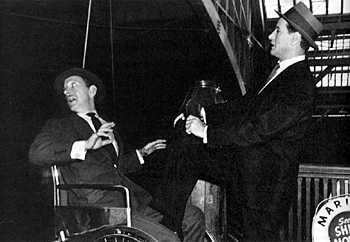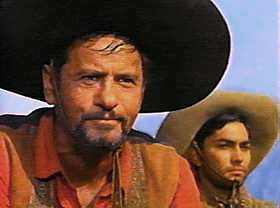|

Eli Wallach as "Dancer" pushes "The Man"
to his death in The Lineup.
You subsequently worked for veteran action director Don Siegel, in The Lineup (1958). What was that experience like?
That was my second film. Iíll tell you what, I went into that film with a New York actorís attitude of, you know, what are movies? And Don, who was a skillful moviemaker, understood it. He never liked my attitude, but he knew how to use it in the film. Did you see that? Itís a good movie. I said to them, "Wait, I kill 5 people in one day? My God." And [Siegel] said, "Itís a movie." (Laughs)
Didnít you work on an early 1960s TV program called The Shirley Temple Storybook?
Yes, it was called The Emperorís New Clothes. Yeah. And I did Batman, too. I did Mr. Freeze. I get more mail for him than anything Iíve ever done. I said, "My God, Schwarzenegger just did the same part and he got 20 million." So my wife said, "Well, why donít you lift weights?"
In 1960, you played the bandit leader, Calvera, in the American Western version of Kurosawaís Seven Samurai -- The Magnificent Seven, directed by John Sturges. I think Sturges has often been underrated; he directed some very good films.
Oh, he did Bad Day At Black Rock.
A great movie.
Oh, yeah. We shot it [The Magnificent Seven] all in Mexico, and I said to him, "You know, you never see what the bandits do with the money. They hold up the train, they rob the banks." So I wanted to show what I did with the money. So I got red silk shirts, beautiful hats, wonderful saddles, a great horse, and two gold teeth. So that was the way I did it. Oh, yes. When I saw the movie, I said, "I wish I had heard the music. I would have ridden the horse differently."

Eli Wallach as bandit leader Calvera
in The Magnificent Seven.
You also worked with Steve McQueen on his last film, The Hunter (1980).
Twenty years later, yeah. He was a superb film actor. He knew the cameras. He could ride a horse beautifully. He was exciting on the screen. Most of the stuff he did with the stunts was done in Chicago. So I only worked with him in California.
Itís amazing that he did a lot of his own stunts on that film, considering that he was dying of cancer at the time.
Well, I knew nothing about that. It wasnít until a month after the movie was finished, and a reporter called and said, "Did you know he was dying?" I said, "What are you talking about?" I had no idea.
He did a good job, though.
He sure did. But he said to me once, "I was in my office, and I looked out of my office, and I saw a guy in blue jeans putting stuff in the back of a truck, with a dog running beside him." He said, "Thatís what I wanna do." So he sold his company, stopped doing everything -- I think he knew then that he was going -- he moved up to a little farm with a young lady, got married. Then, he went to Mexico for treatments. Nothing worked. He had, I think, a thing called asbestosis, which is cancer of the lungs. That did him in.
page 2 of 4
 
Go to Eli Wallach filmography.
© 1998 Paul Riordan. All rights reserved.
| 

